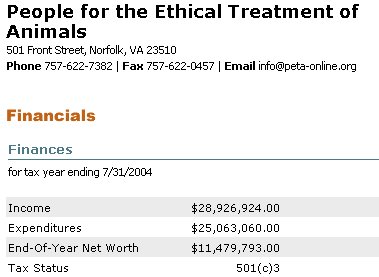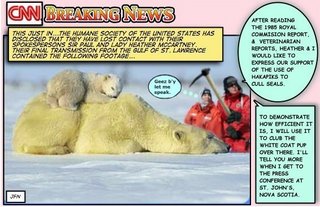(My Reply)
Dear Sir or Madame:
Thank you for your comment. I will take this opportunity to discuss the issue in further detail. I have read considerably on animal rights activists (ARAs) and the seal hunt itself, including Reports of the Canadian Veterinarian Medical Association, & Independent Veterinarians Working Group, and more. They were referenced in other blogs including the one you commented from. I knew The Royal Commission Report on Sealing was a significant study, especially after speaking with a DFO scientist who recommended it because of its relevance for today. Many things have not changed since the report first came out. For example, the sealing methods used are the same, except now, 90% of seals are killed using rifles, and white coats are no longer allowed to be killed. Even at that time, the method using the hakapik was considered very efficient. The methods were and are still considered humane, as much and perhaps even more so than methods used in abbatoirs (see Royal Commission blog below). Since you made light of an important report because of its age, let me provide you with more recent studies which approve of the hunt and methods used. Here are some key excerpts and links to the documents to read for yourself:
From the Canadian Veterinary Journal, in a study called Animal welfare and the harp seal hunt in Atlantic Canada (Sept., 2002)
AbstractMuch attention has been given over the years to animal welfare issues surrounding the seal hunt in Atlantic Canada. However, very little information is available on this subject in the scientific literature. This article reports the results of observations made by representatives of the Canadian Veterinary Medical Association at the hunt in recent years and compares them with observations made by members of the International Fund for Animal Welfare. The conclusion is that the large majority of seals taken during this hunt (at best, 98% in work reported here) are killed in an acceptably humane manner. However, the small proportion of animals that are not killed effectively justifies continued attention to this hunt on the part of the veterinary profession.
(Thanks to blogger skylarkd for sending me that link)
From the Canadian Veterinarians Medical Association Report (2005)
The Canadian Veterinary Medical Association (CVMA) accepts the hunting of seals only if carried out in a humane and sustainable manner.
Young harp seals, approximately 3-4 weeks old, account for 90% or more of the commercial catch in Canadian waters. These animals have particularly thin skulls that can be completely crushed by one or a few strong blows with a hakapik (a long club). Therefore, the CVMA considers this a rapid, efficient, and humane means of killing young seals if conducted properly.
From A Report of the Independent Veterinarians Working Group on the Canadian Harp Seal Hunt (August, 2005)While striking a seal with a hakapik or club is a crude act, and one unlikely to be witnessed by observers without emotion, it is a humane way to render a seal unconscious or dead when carried out correctly by a trained and skilled individual according to the suggested guidelines. (p. 9)
The Group notes that the Canadian harp seal hunt is professional and highly regulated by comparison with seal hunts in Greenland and the North Atlantic. It has the potential to serve as a model to improve humane practice and reduce seal suffering within the other hunts. (p. 23) On Seal Pup Populations
From the Dept. of Fisheries and Oceans web site:
According to a 2004 survey, the Northwest Atlantic harp seal population is now estimated at approximately 5.8 million animals, nearly triple what it was in the 1970s. As many people are aware, animals including seals have a nervous reflex that occurs after stunning and death. Seals have a response called a “swimming reflex”. The Malouf Commission (1987) cited on the DFO Myths & Realities website, clarifies this and states that this reflex is misconceived by observers, (and misinterpreted by ARA’s) as being skinned alive.
Also, for your information, the seals harvested in the Atlantic hunt have very thin skulls and are easily stunned to a state of irreversible unconsciousness where no pain can be felt. In the Gulf seal fishery, until recently three blows from a hakapik were required. Some sealers still do this, but they can tell by feeling the broken skull that both brain hemispheres have been sufficiently damaged (a cracked egg feel), or they perform the “blinking eye” test, or they can determine through the impact of the feel and sound, that the animal is unconscious. At the Front, where 90% of seals are taken, bullets are very effective, as marksmen accuracy is very high. I have personally spoken with a DFO scientist who reinforced information I have just described.
Reason for Writing on the 1985 Royal Commission Report, or any Valid Seal Hunt Study
One of the reasons for taking key excerpts from the Royal Commission Report was to highlight the fact that despite considerable scientific evidence, academic analysis, and ethical arguments in favor of the hunt, ARA's ignore credible reports that validates the hunt – past and present. Another reason is that it’s so comprehensive. It allowed people from many fields of expertise to contribute to the report, and welcomed the input from all concerned parties, including the anti-sealing activists. It also provides important information that is not always presented, e.g., the social, cultural and economic importance of the seal hunt to people and communities. Finally, this document is not online, so people who want solid information can get some key information starting from this blog site.
Next, I will correct some things you said in your comments. First, I did not say anywhere in my writing that ARA’s are only interested in cute animals. I am aware of ARA protests and methods used in other parts of the world. However, these groups are extremely interested in the white seal pup image. As Brian Davies put it in 1970, I see the seal issue as representing a showdown for wildlife. These animals are symbolic.. (p. 72 of the 1985 Royal Commission Report).
Davies knew how to use the media effectively to evoke public emotions, reactions and donations. Paul Watson, a disciple of Davies, has also mastered media manipulation.
 I mean no offence, but he uses it to lure uninformed and unsuspecting people into believing in a cause which is based on fabrications, PR stunts, exaggerated and twisted scientific data. The formula of using the cute seal does not mean that ARA’s only protest the seal hunt, it simply means that this is a very big fundraiser for the ARA cousins, PETA, HSUS, SSCS and other kin I mean no offence, but he uses it to lure uninformed and unsuspecting people into believing in a cause which is based on fabrications, PR stunts, exaggerated and twisted scientific data. The formula of using the cute seal does not mean that ARA’s only protest the seal hunt, it simply means that this is a very big fundraiser for the ARA cousins, PETA, HSUS, SSCS and other kin
This is not just my own analysis. Listen to the words of Paul Watson himself as he answers questions from CBC Radio’s Barbara Frum in 1978. In the interview he blatantly admits that the seal hunt is an easy way to get money rolling in, even though the harp seal is not even an endangered species. He says that there is no way to raise money based on California’s endangered species. This is a pretty telling audiotape, and true to this day. There is a preamble for two minutes or more before the interview.
Click
 here to play audio. here to play audio.
Below is a short segment of the interview:
Click here to read the whole text of the interview.
Barbara Frum: Mr. Watson, how easy is it to raise money against the hunt?
Watson: The seal hunt has always turned a profit for the Greenpeace Foundation. And then other organizations like IFAW, API, Fund for Animals, also make a profit off the seal hunt
Barbara Frum: You suggesting that they fight for seals rather than other animals because it's easy, or easier to raise money that way, or because it's a profit maker for them?
Watson: Well it's definitely because it's easier to make money and because it's easier to make a profit because there are over a thousand animals on the endangered species list, and the harp seal isn't one of them
Barbara Frum: Did anyone in Greenpeace ever express that aloud, that it was easy to make some hay on the seal hunt so let's get into that?
Watson: Well, a lot of people have done that. See the thing is the seal is very easy to exploit as an image. We have posters, we have buttons, we have shirts, all of which portray the head of a baby seal with the tears coming out of its eyes. Baby seals are always crying because — its — they're always — the salt tears keep their eyes from freezing. But they have this image — they're baby animals, they're beautiful, and because of that ...
|
People like Brian Davies and Paul Watson have been successful in the last 35 years in creating in the social milieu, a negative associated meaning with the term seal hunt. Over the years, and now more than ever, key negative words are used to equate sealers, Newfoundland, Newfoundlanders, and sealing with being barbaric, murderous, greedy, cruel, nazi-like, and even demented, not unlike the image of killers in slasher movies like Friday the 13th. And more obviously, the idea of clubbing a seal is not described as being an efficient method of killing, as researchers repeatedly say, but rather it is equated with something that is old-fashioned, backward, uneducated, and outdated. It seems to play to people’s insecurities about how others view Canada.
It is conceivable that a celebrity like McCartney could actually say what experts tell us. People’s perception of sealers using a hakapik could really be reversed if an informed celebrity told it like it is. Imagine McCartney saying, I want everyone to know that even though it may look brutal, this method of sealing is very humane and quick. Then celebrity media could be used for factual information.
Getting back to your comments, I suggested that celebrities are often misinformed and used, or simply ignorant, but they do function to attract wide attention and big cash for big payrolls. In the case of the McCartneys either this was true or they shamelessly projected an uncivilized and false image of a civilized people. But why wouldn’t PETA and other ARA’s use them to draw attention? It does increase viewers and it acts like an infomercial when the celebrities direct viewers to a web site and phone number to make donations. CNN itself is actually a window into peoples’ fixation with celebrities. For almost two years, CNN itself could very well have been called the Scott & Laci Peterson Station, or the OJ Station in 1995-96. The president of PETA, Ingrid Newkirk said about PETA’s publicity methods, PETA's publicity formula -- eighty percent outrage, ten percent each of celebrity and truth.
(The New Yorker, 2003)
If you still don’t think celebrities are used to bring in the goods, then consider this sample of the Larry King show with the McCartneys and Premier Danny Williams:
H. MCCARTNEY: And, if you go onto www.protectseals.org you can see exactly what goes on and click on to say if you support the ban of this seal hunt, so protectseals.org and any help there donation wise can really help push this forward.
It was obvious to anyone watching, that the Larry King show of was a one hour PETA advertisement. At least the first half hour of the show was devoted to Heather & Paul McCartney’s plea to the public to help and stop the seal hunt by visiting an HSUS sponsored website, and calling a number to donate. Preceding commercials, there were at least two video clips where Paul, and Heather appealled to the public to donate:
(from the transcript of The Larry King Live show of March 3, 2006)
(BEGIN VIDEO CLIP)
P. MCCARTNEY: In about three weeks time these baby seals are due to be clubbed to death or shot in what's known as the seal hunt. For many years, people have been trying to have this brutal practice stopped but we are out here to see if we can lend our voice to this campaign and maybe get it stopped once and for all.
(END VIDEO CLIP) (COMMERCIAL BREAK)
(BEGIN VIDEO CLIP)
H. MCCARTNEY: Sadly, you won't be able to stop these beautiful baby seals around us being bludgeoned to death in the next few weeks but hopefully we could if we all join together and put pressure on the Canadian government to do what is just humane and stop this seal hunt, hopefully this would be the last seal hunt.
(END VIDEO CLIP)
|
By the way, this is a snapshot of PETA’s income statement, a subject for another blog in itself.

Slaughterhouse
These are your words, not mine: slaughterhouses are just as bad. My point in mentioning a worker’s experience in a slaughterhouse was to reiterate what reports like those mentioned above say, i.e., that the seal fishery is as humane as regular animal slaughter. Also, the point is that any animal industry done on a white background will create a distasteful image anytime. Billions of people like to eat chicken, turkey, beef and pork, but no one wants to see a Discovery channel show of How it’s Made about how meat is harvested. For ARA’s to continually show blood soaked snow images is actually insulting to viewer’s intelligence. People know what killing animals involve. I don’t think that there are many out there who believe cattle all just pass peacefully away. Having said that, like any Canadian, I want to take comfort in knowing that an industry in my province is humane and is continually being checked and regulated like all other animal industries. That’s why I have inquired about the hunt, and referenced the above studies.
Finally, it is not necessary to suggest alternate industries, as the seal fishery is humane, efficient, and contrary to what you call failing, quite successful and self-sustaining. Your use of the statement “there ARE alternatives” is just another piece of PR communications psychology, which infers to the public that, Newfoundland’s rationale for justifying the seal hunt is because we don’t think there are alternatives. Again, this is using the public’s lack of attention to and ignorance of the issue, to falsely present a situation which does not exist, thus, tricking the public. The PR used by ARA’s have gotten sophisticated enough to use this sneaky technique. A similar tactic is used when activists spokes people say that “seals did not cause the cod fish collapse.” Again, that type of statement is proclaimed to infer that Newfoundlanders exclusively blame seals for the total collapse of the cod. As Newfoundlanders & Labradorians and other educated people know, there are many factors in the cod collapse, including foreign overfishing, water temperature change, and possibly including to some degree, predators like seals.
With respect reader, I’m sure you and many others sincerely have animal welfare in mind. There are plenty of places in the world where real inhumane treatment of animals take place daily. However, the ice fields off Newfoundland and Labrador are not included with them. In spite of healthy seal populations, and approval from experts and international organizations who consider the hunt humane, ARA’s still refute those findings. They will not let go of the seal hunt because it is still, as Paul Watson said, an easy way to raise money. Please consider the evidence presented here and consider carrying out animal welfare work with a more respected and honest organization.
P.S.
Just for your information, there are at least 8 boat tour and whale watching ventures in northern NL coastal areas where the seal hunt takes place.
Also see the Department of Fisheries & Oceans website to learn more about the Myths & Realities of the Seal. |


 Instead, she chose to use her fame, time and energy to put an end to a humane and legal seal fishery, that helps feed and clothe 1000's of Canadians. The actions of celebs like Anderson have no doubt fattened the bank accounts of Animal Rights Activists(ARAs) groups. It's too bad that the image of a baby refugee does not stir the same outcry as a baby seal does. But that's not surprising because groups like PETA believe that animals have the very same rights as humans.
Instead, she chose to use her fame, time and energy to put an end to a humane and legal seal fishery, that helps feed and clothe 1000's of Canadians. The actions of celebs like Anderson have no doubt fattened the bank accounts of Animal Rights Activists(ARAs) groups. It's too bad that the image of a baby refugee does not stir the same outcry as a baby seal does. But that's not surprising because groups like PETA believe that animals have the very same rights as humans.
 and promote the ethical treatment of desperate suffering people.
and promote the ethical treatment of desperate suffering people.

 here
here I mean no offence, but he uses it to lure uninformed and unsuspecting people into believing in a cause which is based on fabrications, PR stunts, exaggerated and twisted scientific data. The formula of using the cute seal does not mean that ARA’s only protest the seal hunt, it simply means that this is a very big fundraiser for the ARA cousins, PETA, HSUS, SSCS and other kin
I mean no offence, but he uses it to lure uninformed and unsuspecting people into believing in a cause which is based on fabrications, PR stunts, exaggerated and twisted scientific data. The formula of using the cute seal does not mean that ARA’s only protest the seal hunt, it simply means that this is a very big fundraiser for the ARA cousins, PETA, HSUS, SSCS and other kin here
here


